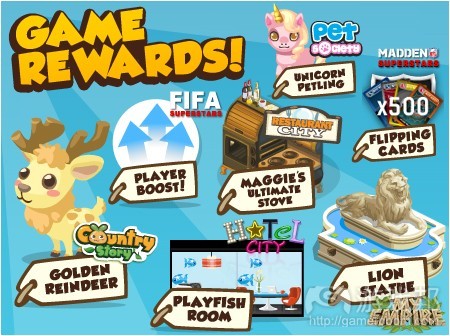社交游戏可供其他行业借鉴的28项设计法则
作者:David Feinleib
如今社交游戏的转变不只停留于在线游戏本身,它带动了用户和企业服务的变化。不论你是否喜欢社交游戏,都应该了解社交游戏中存在的看似轻微却极具影响力的一些原则。
早前的社交游戏:游戏中的进度指示器只能显示游戏的加载速度。
如今的社交游戏:游戏中的图像能够描绘一个城市的发展,为玩家提供一个明确的方位信息。
早前的社交游戏:当你在游戏中得到积分时,你的成绩能够得到相应提高。
如今的社交游戏:玩家通过游戏点击获得积分,同时游戏中的奖励机制也得到了完善。
然而这都只是个开始。以下是社交游戏的28个设计原则:
游戏中的目标和工作——用户粘性:
1.游戏中的故事,即整个游戏的架构。它能使玩家知道自己在游戏中将扮演什么角色,并为玩家在游戏中的进一步操作做好铺垫。
2.主要目标。即玩家在游戏中想要达到的目标,它能为玩家创造一种竞争动态的氛围。
3.最小目标和级别。它能提供给玩家一个明确的方向,推动他们不断“升级”,并带给他们一种成就感。
4.工作。据调查只有45%的美国人喜欢自己的工作,但是在游戏中玩家们却很乐意“工作”,“挣钱”。
5.时间。在游戏中“工作”没有严格的时间限定,玩家能够在游戏期间做其他事,并回头继续进行游戏。
6.对象。在游戏中,玩家能够准备,建造并组合一种形式的工作,但是这种工作却不需要玩家投入百分百的精力去执行。
7.收集。这里利用了人们总是喜欢收集徽章,邮票,艺术品,照片,唱片,明信片等天性。
8.简单的动画。虽然包含复杂的动作,但却很容易理解,且不会耗费开发者太多的制作成本。
病毒式增长——获取用户:
9.为社交游戏中的建筑招募工作人员,需要他人提供帮助。
10.玩家只有在邀请朋友加入游戏才能获得相应的游戏道具。
11.社交目标要求玩家邀请朋友或其他玩家一起进行游戏。
12.很多情况下玩家只有在邀请其他玩家进入游戏后才能得到相应的积分。
13.当玩家主动赠送礼物或游戏道具给其他玩家时,他也同样能够获得他人回赠的礼物或道具。
14.与其他玩家分享游戏场景,角色,宠物或道具等的图片(或截图)能够带给玩家一种自豪感。
15.Wall posting是社交游戏中的一种免费的营销手段,能够对现有的游戏用户产生重要的影响。
16.意见箱使玩家能够根据从朋友那得到的一些评价或建议而做出相应的改变。
游戏机制——用户行为和盈利:
17.虚拟音效使得一些虚拟目标和行动更具有真实感。
18.通过点击获取的虚拟货币。这种机制为玩家创造了一种奖励动态的氛围。
19.屏幕上的目标提醒和锁定的游戏道具能够不断提醒玩家去邀请朋友,并努力完成游戏任务。
20.帮助玩家一步一步进行游戏并取得成功。在游戏期间,玩家将能收到一些关于游戏的指南信息,以更好地进行游戏。
21.虚拟向导。这种机制使得游戏更加具有人性化且能令玩家信服,并能在玩家心中留下深刻印象。
22.游戏访问。通过一些例子不断提醒玩家他们应该为何种目标而努力进行游戏。
23.可用性受限和即将期满的游戏道具都能使玩家感受到一种紧迫感。
24.游戏徽章代表玩家在游戏中的地位。
25.游戏提供给玩家多重的游戏积分能够使他们连续多天登陆游戏界面进行游戏。
26.诸如免费游戏这类的奖励告示能够推动玩家打开邮箱并点击获取相应奖励。
27.在游戏中拥有土地并寻求扩展(游戏邦注:并非指企业销售)能够激励玩家在游戏中购买道具并努力建造,填充属于自己的空间。
28.游戏内购买功能。这意味着玩家不需要切换游戏界面去购买虚拟产品。
以上所列出的只是当今社交游戏中应用的设计原则中的一部分。虽然早前就有一些传统游戏应用了这些原则,但是社交版图的影响使这些原则比起之前的游戏更具有影响大众用户的作用。这些原则将不再局限于硬核游戏玩家。我们将不只是在游戏中看到这些原则的实施,同时也能在各个网站,服务和手机应用中看到它们的存在。把这些原则应用到你们所提供的服务中去吧,因为它们已经成为当今社会的的一种趋势了!(本文为游戏邦/gamerboom.com编译,如需转载请联系:游戏邦)
Leading Edge Design Principles from Social Games
With social games seeing some incredible growth over the holidays, it seemed appropriate to start the New Year off with a post on the topic.
Today’s social games are transforming not only online gaming itself but consumer and enterprise services as well. Love ‘em or hate ‘em, there’s a lot to be learned from their powerful yet subtle principles.
Old: A progress bar that does nothing more than tell you the game is loading.
New: Graphics illustrating the growth of a city, which send the player a powerful aspirational message.
Old: Your score increases as you earn points.
New: Coins appear on screen and reinforce a reward dynamic by requiring you to click on them.
That’s just the beginning. Here are 28 design principles from social games:
Goals and work – Engagement:
1. The story is the setup for the game. It tells you who you are and sets the stage for…
2. The major goal is what players are trying to accomplish and creates a competitive dynamic.
3. Minor goals + levels provide direction, a way to move up, and a sense of accomplishment.
4. Work. Only 45% of Americans like their jobs, but in games work is fun and enables earning.
5. Time. Work takes time, forcing the player to do other activities and return.
6. Objects. Players prepare, build, or assemble, a form of work, in which nothing comes complete.
7. Collections. People love to collect not just badges but stamps, art, photos, music, postcards…
8. Simple animations represent complex actions yet are easy to understand and inexpensive to create.
Viral Growth – Adoption:
9. Staffing requires other people.
10. Socially locked items only unlock if you invite friends.
11. Social goals require the involvement of friends or other players.
12. Points can in some cases only be earned by involving others.
13. Gifting items that you must give away or get points for giving away promotes reciprocity.
14. Sharing photos (screenshots) of scenes/people/pets/ items provides a sense of pride.
15. Wall posting is free marketing that leverages existing users.
16. Suggestions to invite friends produce some number of conversions.
Game mechanics – User behavior and monetization:
17. Sound effects lend authenticity to virtual objects and actions.
18. Clickable coins, which users must click to get, create a subtle click/reward dynamic.
19. On-screen goals + locked items constantly remind the user to invite friends + complete objectives.
20. Success step by step, illustrated during game loading, sends a subtle aspirational message.
21. Virtual guide makes the game personable and trusted and gives the player someone to impress.
22. Visiting (virtual guides and real players) reminds users what they are striving for by example.
23. Limited availability and expiring items create scarcity and a sense of urgency.
24. Badges are a form of status.
25. Repeat points reward players for returning multiple days in a row.
26. Notifications with incentives such as free gifts give users a reason to open emails and click.
27. Land and expand (not the enterprise sales kind!) causes players to buy items to build and fill space.
28. In-game purchasing means players don’t need to leave to buy.
These are just a few of the design principles today’s social games are applying. Many have been used by more traditional games for years, but their leverage of widespread social graphs makes them much more widespread and impactful on a much larger user base than ever before. They’re no longer restricted to hard-core gamers. Soon enough, they’ll be everywhere, from the games themselves to just about every web site, service, and mobile offering available. Apply these principles to your service today!(source:vcdave)








































 闽公网安备35020302001549号
闽公网安备35020302001549号